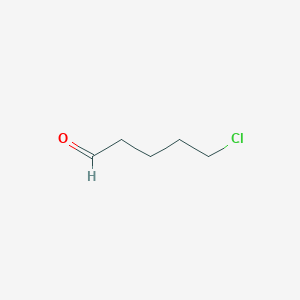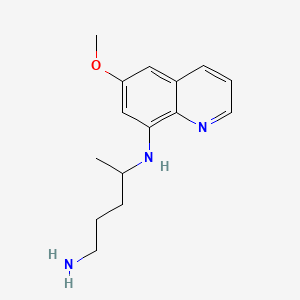
Primaquin
Übersicht
Beschreibung
Primaquin ist ein Medikament, das hauptsächlich zur Behandlung und Vorbeugung von Malaria eingesetzt wird, insbesondere gegen die schlafenden Leberformen des Parasiten Plasmodium vivax und Plasmodium ovale . Es wird auch in Kombination mit anderen Medikamenten zur Behandlung von Pneumocystis-Pneumonie eingesetzt . This compound wurde erstmals 1946 synthetisiert und ist in der Liste der unentbehrlichen Medikamente der Weltgesundheitsorganisation enthalten .
Wirkmechanismus
Target of Action
Primaquine, an 8-aminoquinoline, primarily targets the liver stages of the malaria parasites, specifically Plasmodium vivax and Plasmodium ovale . It is also effective against the sexual stage of the Plasmodium parasite .
Mode of Action
It is believed to interfere with a part of the parasite (mitochondria) that is responsible for supplying it with energy . Without energy, the parasite dies, stopping the infection from continuing and allowing the person to recover .
Pharmacokinetics
Primaquine is well-absorbed in the gut and extensively distributed in the body without accumulating in red blood cells . Its elimination half-life is reported to be around 6 hours . Primaquine’s bioavailability is increased when taken with food or grapefruit juice .
Result of Action
The result of Primaquine’s action is the death of the malaria parasite. By interfering with the parasite’s energy supply, Primaquine stops the infection from continuing, allowing the person to recover . It also prevents the relapse of vivax and ovale malarias following treatment with a blood schizontocide .
Wissenschaftliche Forschungsanwendungen
Primaquin hat eine breite Palette von Anwendungen in der wissenschaftlichen Forschung:
Wirkmechanismus
Der genaue Wirkmechanismus von this compound ist nicht vollständig geklärt. Es wird vermutet, dass es die Energieproduktion im Malariaparasiten stört, indem es auf seine Mitochondrien abzielt . Diese Störung führt zur Bildung reaktiver Sauerstoffspezies, die die zellulären Bestandteile des Parasiten schädigen und ihn letztendlich abtöten . This compound kann auch an die protozoale DNA binden und ihre Eigenschaften verändern .
Biochemische Analyse
Biochemical Properties
Primaquine interacts with various enzymes, proteins, and other biomolecules. It is metabolized in humans via three pathways . The first pathway involves direct glucuronide/glucose/carbamate/acetate conjugation of Primaquine. The second pathway involves hydroxylation (likely cytochrome P450-mediated) at different positions on the quinoline ring, with mono-, di-, or even tri-hydroxylations possible, and subsequent glucuronide conjugation of the hydroxylated metabolites . The third pathway involves the monoamine oxidase catalyzed oxidative deamination of Primaquine resulting in the formation of Primaquine-aldehyde, Primaquine alcohol, and carboxy Primaquine (cPQ), which are further metabolized through additional phase I hydroxylations and/or phase II glucuronide conjugations .
Cellular Effects
Primaquine has significant effects on various types of cells and cellular processes. It interferes with a part of the parasite (mitochondria) that is responsible for supplying it with energy . Without energy, the parasite dies, stopping the infection from continuing and allowing the person to recover .
Molecular Mechanism
It may be acting by generating reactive oxygen species or by interfering with the electron transport in the parasite . Primaquine may also bind to and alter the properties of protozoal DNA .
Temporal Effects in Laboratory Settings
In laboratory settings, the effects of Primaquine change over time. A single low-dose of Primaquine was found to be haematologically safe in a population of G6PD-normal and G6PD-deficient African males without malaria . The study observed haemoglobin levels up to 28 days after drug administration .
Dosage Effects in Animal Models
In animal models, the effects of Primaquine vary with different dosages . The plasma AUC 0-last (µg h/mL) (1.6 vs. 0.6), T 1/2 (h) (1.9 vs. 0.45), and T max (h) (1 vs. 0.5) were greater for S-Primaquine as compared to R-Primaquine .
Metabolic Pathways
Primaquine is involved in various metabolic pathways. As mentioned earlier, it is metabolized in humans via three pathways . These pathways involve various enzymes and cofactors, and can also affect metabolic flux or metabolite levels .
Transport and Distribution
Primaquine is transported and distributed within cells and tissues . The concentration of S-Primaquine was found to be higher in all tissues . At T max, (0.5–1 h in all tissues), the level of S-Primaquine was 3 times that of R-Primaquine in the liver .
Vorbereitungsmethoden
Synthesewege und Reaktionsbedingungen
Primaquin wird durch einen mehrstufigen Prozess ausgehend von 8-Aminoquinolin synthetisiert. . Die Reaktionsbedingungen beinhalten typischerweise die Verwendung von starken Basen und organischen Lösungsmitteln, um die Substitutionsreaktionen zu erleichtern.
Industrielle Produktionsverfahren
Die industrielle Produktion von this compound beinhaltet eine großtechnische Synthese unter ähnlichen Reaktionsbedingungen wie bei der Laborsynthese, jedoch optimiert für höhere Ausbeuten und Reinheit. Der Prozess umfasst strenge Reinigungsschritte, um sicherzustellen, dass das Endprodukt pharmazeutische Standards erfüllt .
Analyse Chemischer Reaktionen
Arten von Reaktionen
Primaquin durchläuft verschiedene chemische Reaktionen, darunter:
Reduktion: Die Verbindung kann auch Reduktionsreaktionen unterliegen, insbesondere in Gegenwart von Reduktionsmitteln.
Substitution: This compound kann an Substitutionsreaktionen teilnehmen, insbesondere an den Amino- und Methoxygruppen.
Häufige Reagenzien und Bedingungen
Häufige Reagenzien, die bei den Reaktionen von this compound verwendet werden, sind Oxidationsmittel wie Wasserstoffperoxid, Reduktionsmittel wie Natriumborhydrid und verschiedene organische Lösungsmittel . Die Reaktionen werden typischerweise unter kontrollierten Temperatur- und pH-Bedingungen durchgeführt, um sicherzustellen, dass die gewünschten Produkte gebildet werden.
Hauptprodukte, die gebildet werden
Die Hauptprodukte, die aus den Reaktionen von this compound gebildet werden, umfassen seine oxidierten und reduzierten Formen sowie verschiedene substituierte Derivate . Diese Produkte werden oft auf ihre potenziellen pharmakologischen Aktivitäten untersucht.
Vergleich Mit ähnlichen Verbindungen
Primaquin gehört zur Klasse der 8-Aminoquinolin-Verbindungen. Ähnliche Verbindungen umfassen:
Tafenoquin: Wie this compound wird Tafenoquin zur Behandlung und Vorbeugung von Malaria eingesetzt.
Chloroquin: Obwohl es kein 8-Aminoquinolin ist, ist Chloroquin ein weiteres Antimalariamittel, das auf die Blutstadien des Parasiten abzielt.
Die Einzigartigkeit von this compound liegt in seiner Fähigkeit, die schlafenden Leberformen von Malariaparasiten zu eliminieren, was es für die Verhinderung von Rückfällen unerlässlich macht .
Eigenschaften
IUPAC Name |
4-N-(6-methoxyquinolin-8-yl)pentane-1,4-diamine | |
|---|---|---|
| Source | PubChem | |
| URL | https://pubchem.ncbi.nlm.nih.gov | |
| Description | Data deposited in or computed by PubChem | |
InChI |
InChI=1S/C15H21N3O/c1-11(5-3-7-16)18-14-10-13(19-2)9-12-6-4-8-17-15(12)14/h4,6,8-11,18H,3,5,7,16H2,1-2H3 | |
| Source | PubChem | |
| URL | https://pubchem.ncbi.nlm.nih.gov | |
| Description | Data deposited in or computed by PubChem | |
InChI Key |
INDBQLZJXZLFIT-UHFFFAOYSA-N | |
| Source | PubChem | |
| URL | https://pubchem.ncbi.nlm.nih.gov | |
| Description | Data deposited in or computed by PubChem | |
Canonical SMILES |
CC(CCCN)NC1=C2C(=CC(=C1)OC)C=CC=N2 | |
| Source | PubChem | |
| URL | https://pubchem.ncbi.nlm.nih.gov | |
| Description | Data deposited in or computed by PubChem | |
Molecular Formula |
C15H21N3O | |
| Source | PubChem | |
| URL | https://pubchem.ncbi.nlm.nih.gov | |
| Description | Data deposited in or computed by PubChem | |
Related CAS |
63-45-6 (1:2 PO4) | |
| Record name | Primaquine [INN:BAN] | |
| Source | ChemIDplus | |
| URL | https://pubchem.ncbi.nlm.nih.gov/substance/?source=chemidplus&sourceid=0000090346 | |
| Description | ChemIDplus is a free, web search system that provides access to the structure and nomenclature authority files used for the identification of chemical substances cited in National Library of Medicine (NLM) databases, including the TOXNET system. | |
DSSTOX Substance ID |
DTXSID8023509 | |
| Record name | Primaquine | |
| Source | EPA DSSTox | |
| URL | https://comptox.epa.gov/dashboard/DTXSID8023509 | |
| Description | DSSTox provides a high quality public chemistry resource for supporting improved predictive toxicology. | |
Molecular Weight |
259.35 g/mol | |
| Source | PubChem | |
| URL | https://pubchem.ncbi.nlm.nih.gov | |
| Description | Data deposited in or computed by PubChem | |
Physical Description |
Solid | |
| Record name | Primaquine | |
| Source | Human Metabolome Database (HMDB) | |
| URL | http://www.hmdb.ca/metabolites/HMDB0015219 | |
| Description | The Human Metabolome Database (HMDB) is a freely available electronic database containing detailed information about small molecule metabolites found in the human body. | |
| Explanation | HMDB is offered to the public as a freely available resource. Use and re-distribution of the data, in whole or in part, for commercial purposes requires explicit permission of the authors and explicit acknowledgment of the source material (HMDB) and the original publication (see the HMDB citing page). We ask that users who download significant portions of the database cite the HMDB paper in any resulting publications. | |
Boiling Point |
175-179 °C | |
| Record name | Primaquine | |
| Source | DrugBank | |
| URL | https://www.drugbank.ca/drugs/DB01087 | |
| Description | The DrugBank database is a unique bioinformatics and cheminformatics resource that combines detailed drug (i.e. chemical, pharmacological and pharmaceutical) data with comprehensive drug target (i.e. sequence, structure, and pathway) information. | |
| Explanation | Creative Common's Attribution-NonCommercial 4.0 International License (http://creativecommons.org/licenses/by-nc/4.0/legalcode) | |
| Record name | PRIMAQUINE | |
| Source | Hazardous Substances Data Bank (HSDB) | |
| URL | https://pubchem.ncbi.nlm.nih.gov/source/hsdb/6516 | |
| Description | The Hazardous Substances Data Bank (HSDB) is a toxicology database that focuses on the toxicology of potentially hazardous chemicals. It provides information on human exposure, industrial hygiene, emergency handling procedures, environmental fate, regulatory requirements, nanomaterials, and related areas. The information in HSDB has been assessed by a Scientific Review Panel. | |
Solubility |
5.64e-02 g/L | |
| Record name | Primaquine | |
| Source | Human Metabolome Database (HMDB) | |
| URL | http://www.hmdb.ca/metabolites/HMDB0015219 | |
| Description | The Human Metabolome Database (HMDB) is a freely available electronic database containing detailed information about small molecule metabolites found in the human body. | |
| Explanation | HMDB is offered to the public as a freely available resource. Use and re-distribution of the data, in whole or in part, for commercial purposes requires explicit permission of the authors and explicit acknowledgment of the source material (HMDB) and the original publication (see the HMDB citing page). We ask that users who download significant portions of the database cite the HMDB paper in any resulting publications. | |
Mechanism of Action |
Primaquine's mechanism of action is not well understood. It may be acting by generating reactive oxygen species or by interfering with the electron transport in the parasite. Also, although its mechanism of action is unclear, primaquine may bind to and alter the properties of protozoal DNA., The precise mechanism of action has not been determined, but may be based on primaquine's ability to bind to and alter the properties of DNA. Primaquine is highly active against the exoeryhrocytic stages of plasmodium vivax and plasmodium ovale and against the primary exoerythrocytic stages of plasmodium falciparum. It is also highly active against the sexual forms of (gametocytes) plasmodia, especially P. falciparum, disrupting transmission of the disease by eliminating the reservoir from which the mosquito carrier is infected., /Primaquine/ disrupts the parasitic mitochondria, thereby interrupting metabolic processes requiring energy., ... /Primaquine is one/ of /aromatic amine-containing/ xenobiotics ... capable to inducing oxidative injury in erythrocytes. These agents appear to potentiate the normal redox reactions and are capable of overwhelming the usual protective mechanisms. The interaction between these xenobiotics and hemoglobin leads to the formation of free radicals that denature critical proteins, including hemoglobin, thiol-dependent enzymes, and components of the erythrocyte membrane ... Oxidative denaturation of the globin chain decreases its affinity for the heme group, which may dissociate from the globin chain during oxidative injury ... The generation of free radicals may also lead to peroxidation of membrane lipids. This may affect the deformability of the erythrocyte and the permeability of the membrane to potassium. The alteration of the Na(+)/K(+) gradient is ... potentially lethal to the affected erythrocyte. Oxidative injury also impairs the metabolic machinery of the erythrocyte, resulting in a decrease in the concentration of ATP. Damage to the membrane can also permit leakage of denatured hemoglobin from the cell. Such free denatured hemoglobin can be toxic on its own. Free hemoglobin may irreversibly bind nitric oxide, resulting in vasoconstriction. Released hemoglobin may form nephrotoxic hemoglobin dimers, leading to kidney damage. /Oxidative hemolysis/ | |
| Record name | Primaquine | |
| Source | DrugBank | |
| URL | https://www.drugbank.ca/drugs/DB01087 | |
| Description | The DrugBank database is a unique bioinformatics and cheminformatics resource that combines detailed drug (i.e. chemical, pharmacological and pharmaceutical) data with comprehensive drug target (i.e. sequence, structure, and pathway) information. | |
| Explanation | Creative Common's Attribution-NonCommercial 4.0 International License (http://creativecommons.org/licenses/by-nc/4.0/legalcode) | |
| Record name | PRIMAQUINE | |
| Source | Hazardous Substances Data Bank (HSDB) | |
| URL | https://pubchem.ncbi.nlm.nih.gov/source/hsdb/6516 | |
| Description | The Hazardous Substances Data Bank (HSDB) is a toxicology database that focuses on the toxicology of potentially hazardous chemicals. It provides information on human exposure, industrial hygiene, emergency handling procedures, environmental fate, regulatory requirements, nanomaterials, and related areas. The information in HSDB has been assessed by a Scientific Review Panel. | |
Color/Form |
Viscous liquid | |
CAS No. |
90-34-6 | |
| Record name | Primaquine | |
| Source | CAS Common Chemistry | |
| URL | https://commonchemistry.cas.org/detail?cas_rn=90-34-6 | |
| Description | CAS Common Chemistry is an open community resource for accessing chemical information. Nearly 500,000 chemical substances from CAS REGISTRY cover areas of community interest, including common and frequently regulated chemicals, and those relevant to high school and undergraduate chemistry classes. This chemical information, curated by our expert scientists, is provided in alignment with our mission as a division of the American Chemical Society. | |
| Explanation | The data from CAS Common Chemistry is provided under a CC-BY-NC 4.0 license, unless otherwise stated. | |
| Record name | Primaquine [INN:BAN] | |
| Source | ChemIDplus | |
| URL | https://pubchem.ncbi.nlm.nih.gov/substance/?source=chemidplus&sourceid=0000090346 | |
| Description | ChemIDplus is a free, web search system that provides access to the structure and nomenclature authority files used for the identification of chemical substances cited in National Library of Medicine (NLM) databases, including the TOXNET system. | |
| Record name | Primaquine | |
| Source | DrugBank | |
| URL | https://www.drugbank.ca/drugs/DB01087 | |
| Description | The DrugBank database is a unique bioinformatics and cheminformatics resource that combines detailed drug (i.e. chemical, pharmacological and pharmaceutical) data with comprehensive drug target (i.e. sequence, structure, and pathway) information. | |
| Explanation | Creative Common's Attribution-NonCommercial 4.0 International License (http://creativecommons.org/licenses/by-nc/4.0/legalcode) | |
| Record name | PRIMAQUINE | |
| Source | DTP/NCI | |
| URL | https://dtp.cancer.gov/dtpstandard/servlet/dwindex?searchtype=NSC&outputformat=html&searchlist=27296 | |
| Description | The NCI Development Therapeutics Program (DTP) provides services and resources to the academic and private-sector research communities worldwide to facilitate the discovery and development of new cancer therapeutic agents. | |
| Explanation | Unless otherwise indicated, all text within NCI products is free of copyright and may be reused without our permission. Credit the National Cancer Institute as the source. | |
| Record name | Primaquine | |
| Source | EPA DSSTox | |
| URL | https://comptox.epa.gov/dashboard/DTXSID8023509 | |
| Description | DSSTox provides a high quality public chemistry resource for supporting improved predictive toxicology. | |
| Record name | Primaquine | |
| Source | European Chemicals Agency (ECHA) | |
| URL | https://echa.europa.eu/substance-information/-/substanceinfo/100.001.807 | |
| Description | The European Chemicals Agency (ECHA) is an agency of the European Union which is the driving force among regulatory authorities in implementing the EU's groundbreaking chemicals legislation for the benefit of human health and the environment as well as for innovation and competitiveness. | |
| Explanation | Use of the information, documents and data from the ECHA website is subject to the terms and conditions of this Legal Notice, and subject to other binding limitations provided for under applicable law, the information, documents and data made available on the ECHA website may be reproduced, distributed and/or used, totally or in part, for non-commercial purposes provided that ECHA is acknowledged as the source: "Source: European Chemicals Agency, http://echa.europa.eu/". Such acknowledgement must be included in each copy of the material. ECHA permits and encourages organisations and individuals to create links to the ECHA website under the following cumulative conditions: Links can only be made to webpages that provide a link to the Legal Notice page. | |
| Record name | PRIMAQUINE | |
| Source | FDA Global Substance Registration System (GSRS) | |
| URL | https://gsrs.ncats.nih.gov/ginas/app/beta/substances/MVR3634GX1 | |
| Description | The FDA Global Substance Registration System (GSRS) enables the efficient and accurate exchange of information on what substances are in regulated products. Instead of relying on names, which vary across regulatory domains, countries, and regions, the GSRS knowledge base makes it possible for substances to be defined by standardized, scientific descriptions. | |
| Explanation | Unless otherwise noted, the contents of the FDA website (www.fda.gov), both text and graphics, are not copyrighted. They are in the public domain and may be republished, reprinted and otherwise used freely by anyone without the need to obtain permission from FDA. Credit to the U.S. Food and Drug Administration as the source is appreciated but not required. | |
| Record name | PRIMAQUINE | |
| Source | Hazardous Substances Data Bank (HSDB) | |
| URL | https://pubchem.ncbi.nlm.nih.gov/source/hsdb/6516 | |
| Description | The Hazardous Substances Data Bank (HSDB) is a toxicology database that focuses on the toxicology of potentially hazardous chemicals. It provides information on human exposure, industrial hygiene, emergency handling procedures, environmental fate, regulatory requirements, nanomaterials, and related areas. The information in HSDB has been assessed by a Scientific Review Panel. | |
| Record name | Primaquine | |
| Source | Human Metabolome Database (HMDB) | |
| URL | http://www.hmdb.ca/metabolites/HMDB0015219 | |
| Description | The Human Metabolome Database (HMDB) is a freely available electronic database containing detailed information about small molecule metabolites found in the human body. | |
| Explanation | HMDB is offered to the public as a freely available resource. Use and re-distribution of the data, in whole or in part, for commercial purposes requires explicit permission of the authors and explicit acknowledgment of the source material (HMDB) and the original publication (see the HMDB citing page). We ask that users who download significant portions of the database cite the HMDB paper in any resulting publications. | |
Melting Point |
< 25 °C | |
| Record name | Primaquine | |
| Source | DrugBank | |
| URL | https://www.drugbank.ca/drugs/DB01087 | |
| Description | The DrugBank database is a unique bioinformatics and cheminformatics resource that combines detailed drug (i.e. chemical, pharmacological and pharmaceutical) data with comprehensive drug target (i.e. sequence, structure, and pathway) information. | |
| Explanation | Creative Common's Attribution-NonCommercial 4.0 International License (http://creativecommons.org/licenses/by-nc/4.0/legalcode) | |
| Record name | Primaquine | |
| Source | Human Metabolome Database (HMDB) | |
| URL | http://www.hmdb.ca/metabolites/HMDB0015219 | |
| Description | The Human Metabolome Database (HMDB) is a freely available electronic database containing detailed information about small molecule metabolites found in the human body. | |
| Explanation | HMDB is offered to the public as a freely available resource. Use and re-distribution of the data, in whole or in part, for commercial purposes requires explicit permission of the authors and explicit acknowledgment of the source material (HMDB) and the original publication (see the HMDB citing page). We ask that users who download significant portions of the database cite the HMDB paper in any resulting publications. | |
Synthesis routes and methods
Procedure details




Retrosynthesis Analysis
AI-Powered Synthesis Planning: Our tool employs the Template_relevance Pistachio, Template_relevance Bkms_metabolic, Template_relevance Pistachio_ringbreaker, Template_relevance Reaxys, Template_relevance Reaxys_biocatalysis model, leveraging a vast database of chemical reactions to predict feasible synthetic routes.
One-Step Synthesis Focus: Specifically designed for one-step synthesis, it provides concise and direct routes for your target compounds, streamlining the synthesis process.
Accurate Predictions: Utilizing the extensive PISTACHIO, BKMS_METABOLIC, PISTACHIO_RINGBREAKER, REAXYS, REAXYS_BIOCATALYSIS database, our tool offers high-accuracy predictions, reflecting the latest in chemical research and data.
Strategy Settings
| Precursor scoring | Relevance Heuristic |
|---|---|
| Min. plausibility | 0.01 |
| Model | Template_relevance |
| Template Set | Pistachio/Bkms_metabolic/Pistachio_ringbreaker/Reaxys/Reaxys_biocatalysis |
| Top-N result to add to graph | 6 |
Feasible Synthetic Routes
Q1: How does primaquine exert its antimalarial effects?
A1: While the exact mechanism of action remains incompletely understood, primaquine is known to target the liver stages of Plasmodium vivax and Plasmodium ovale malaria, specifically the dormant hypnozoites responsible for relapses. Primaquine's activity is believed to stem from its metabolites, which are thought to generate reactive oxygen species, leading to oxidative damage within the parasite. [, , ]
Q2: What is the role of primaquine metabolites in its antimalarial activity?
A2: Primaquine itself is a prodrug requiring bioactivation to exert its antimalarial effects. This bioactivation process involves enzymatic conversion, likely by cytochrome P450 enzymes, into active metabolites. [, ] One such metabolite, primaquine-5,6-orthoquinone (5,6-POQ), has been identified as a key mediator of primaquine's activity against Plasmodium parasites. []
Q3: Is primaquine effective against the blood stages of malaria parasites?
A3: Primaquine exhibits limited activity against the asexual blood stages of Plasmodium falciparum compared to its potent activity against liver-stage hypnozoites. [, , ]
Q4: What is the molecular formula and weight of primaquine?
A4: The molecular formula of primaquine is C15H21N3O, and its molecular weight is 259.34 g/mol.
Q5: How is primaquine metabolized in the body?
A5: Primaquine undergoes extensive metabolism in the liver, primarily via cytochrome P450 enzymes, particularly CYP2D6. This metabolism leads to the formation of various metabolites, some of which contribute to its antimalarial activity while others are associated with its toxicity. [, , ]
Q6: Does gender influence the pharmacokinetics of primaquine?
A6: Pharmacokinetic studies indicated comparable primaquine disposition between men and women, suggesting no need for dose adjustments based on sex. [, ]
Q7: How effective is primaquine in preventing relapses of Plasmodium vivax malaria?
A7: Primaquine is highly effective in preventing P. vivax relapses when administered at appropriate doses and durations. Clinical trials have demonstrated a significant reduction in relapse rates with higher total primaquine doses (≥5 mg/kg). []
Q8: Is there evidence of primaquine resistance?
A8: While widespread primaquine resistance has not been conclusively documented, several factors can impact treatment outcomes. These include variations in parasite susceptibility, host factors such as G6PD deficiency, and suboptimal adherence to prescribed primaquine regimens. [, , ]
Q9: What is the role of CYP2D6 polymorphisms in primaquine efficacy?
A9: CYP2D6 genetic variations, particularly those resulting in decreased enzyme activity, can significantly impact primaquine metabolism and reduce its efficacy. This highlights the importance of understanding the pharmacogenetics of primaquine for personalized treatment strategies. []
Q10: What are the major safety concerns associated with primaquine use?
A10: The primary concern is hemolytic anemia in individuals with G6PD deficiency. This enzyme is crucial for protecting red blood cells from oxidative damage, and its deficiency can lead to drug-induced hemolysis, particularly with primaquine and other 8-aminoquinolines. [, , , , ]
Q11: Are there strategies to improve primaquine delivery to its target sites?
A11: Researchers have explored nanoparticle formulations of primaquine to enhance its delivery to the liver, aiming to improve its efficacy against liver-stage parasites while potentially minimizing systemic exposure and associated toxicity. One study demonstrated that primaquine-loaded chitosan nanoparticles achieved a threefold increase in liver primaquine concentrations compared to conventional primaquine in rats. [, ]
Q12: What analytical methods are employed to quantify primaquine and its metabolites?
A12: Liquid chromatography coupled with mass spectrometry (LC-MS) is commonly utilized for the sensitive and specific quantification of primaquine and its metabolites in biological samples. This technique allows for the separation and detection of different chemical entities based on their mass-to-charge ratio, enabling comprehensive pharmacokinetic analyses. [, ]
Q13: How is the enantiomeric separation of primaquine and its metabolites achieved?
A13: Chiral chromatography, employing specialized stationary phases designed to separate enantiomers, is used to isolate and quantify individual enantiomers of primaquine and its metabolites. This technique is crucial for understanding potential differences in the pharmacological and toxicological profiles of individual enantiomers. []
Haftungsausschluss und Informationen zu In-Vitro-Forschungsprodukten
Bitte beachten Sie, dass alle Artikel und Produktinformationen, die auf BenchChem präsentiert werden, ausschließlich zu Informationszwecken bestimmt sind. Die auf BenchChem zum Kauf angebotenen Produkte sind speziell für In-vitro-Studien konzipiert, die außerhalb lebender Organismen durchgeführt werden. In-vitro-Studien, abgeleitet von dem lateinischen Begriff "in Glas", beinhalten Experimente, die in kontrollierten Laborumgebungen unter Verwendung von Zellen oder Geweben durchgeführt werden. Es ist wichtig zu beachten, dass diese Produkte nicht als Arzneimittel oder Medikamente eingestuft sind und keine Zulassung der FDA für die Vorbeugung, Behandlung oder Heilung von medizinischen Zuständen, Beschwerden oder Krankheiten erhalten haben. Wir müssen betonen, dass jede Form der körperlichen Einführung dieser Produkte in Menschen oder Tiere gesetzlich strikt untersagt ist. Es ist unerlässlich, sich an diese Richtlinien zu halten, um die Einhaltung rechtlicher und ethischer Standards in Forschung und Experiment zu gewährleisten.
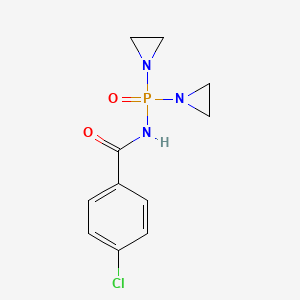


![2-Propanol, 1,1',1'',1'''-[[(2-hydroxypropyl)imino]bis(2,1-ethanediylnitrilo)]tetrakis-](/img/structure/B1584618.png)
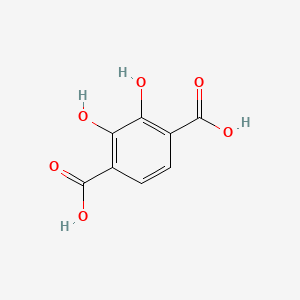
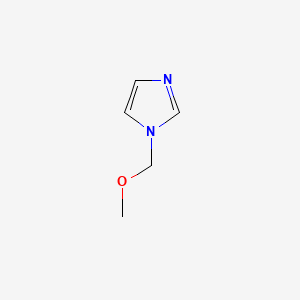
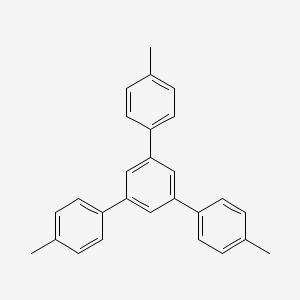

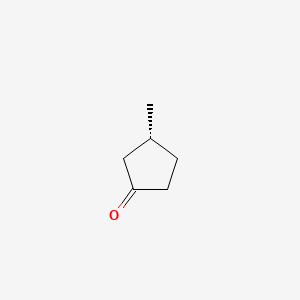
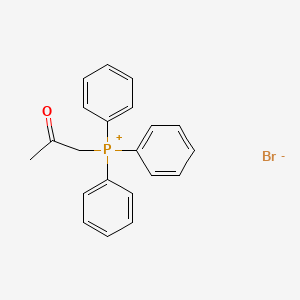
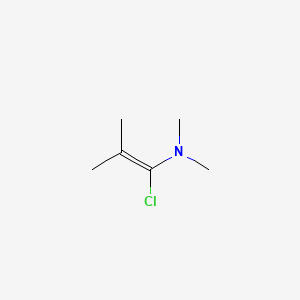
![3-Bromofuro[3,2-b]pyridine](/img/structure/B1584629.png)

